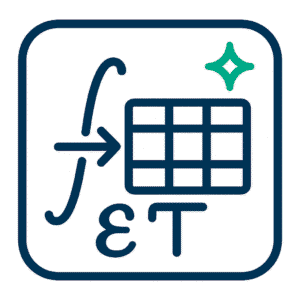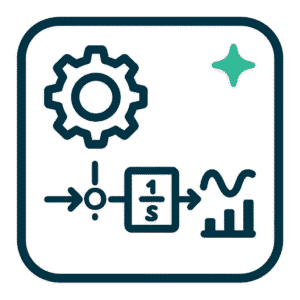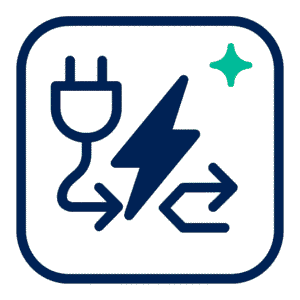Core algebraic rules (compact)
The standard substitutions for unilateral Laplace transforms are:
ℒ{f'(t)} = sF(s) − f(0⁺).ℒ{f''(t)} = s²F(s) − s f(0⁺) − f'(0⁺).- Time-shift:
u(t−a)f(t−a) ↔ e^(−a s) F(s). - Linearity, convolution
ℒ{f*g}=F(s)G(s), and frequency shifte^{a t}f(t) ↔ F(s−a).
A compact Laplace table and worked partial-fraction patterns are essential; authoritative tables and worked examples are available from course material and online references such as MIT OpenCourseWare — Differential Equations and Paul’s Online Math Notes.

Method outline for ODEs
- Take unilateral Laplace transforms of both sides of the ODE, using initial conditions explicitly.
- Rearrange the resulting algebraic equation to solve for the unknown transform
Y(s). - Decompose
Y(s)into canonical pieces by partial fractions, time shifts, or known transforms. - Invert termwise with a table or a symbolic inverse routine; if needed, use numeric inversion.
- Validate by forward-transforming the obtained
y(t)and verifying the originalY(s)at representative s-values.
Software that supports laplace transform step-by-step or a laplace transform calculator online helps validate intermediate algebra and numerical inversions.
Worked Example 1 — First-order forced ODE
Solve
y'(t) + 3y(t) = sin t, y(0)=2.Step 1 (transform). Let Y(s)=ℒ{y(t)}. Apply rules:
sY(s) − y(0) + 3Y(s) = ℒ{sin t} = 1/(s²+1).Insert y(0)=2:
(s+3)Y(s) − 2 = 1/(s²+1).Step 2 (algebra).
Y(s) = 2/(s+3) + 1/((s+3)(s²+1)).Step 3 (partial fractions). Decompose
1/((s+3)(s²+1)) = A/(s+3) + (Bs + C)/(s²+1).Solving yields A = 1/10, B = −1/10, C = 3/10, so
Y(s) = (21/10)/(s+3) + (−(1/10)s + 3/10)/(s²+1).Step 4 (invert). Use table entries:
ℒ⁻¹{1/(s+3)} = e^{−3t}.ℒ⁻¹{s/(s²+1)} = cos t,ℒ⁻¹{1/(s²+1)} = sin t.
Therefore
y(t) = (21/10)e^{−3t} − (1/10)cos t + (3/10)sin t.This result can be checked by forward transformation or by using a laplace transform practice solver or symbolic engine.
Worked Example 2 — Second-order with unit step forcing
Solve
y'' + 4y = u(t−1), y(0)=0, y'(0)=0,where u(t−1) is the unit step delayed by 1.
Step 1 (transform).
s²Y(s) + 4Y(s) = ℒ{u(t−1)} = e^{−s}/s,so
Y(s) = e^{−s}/(s(s²+4)).Step 2 (time-shift inversion). Recognise Y(s)=e^{−s}G(s) with G(s)=1/(s(s²+4)). Invert G(s) first, then apply the time shift: y(t) = u(t−1) g(t−1) where g = ℒ⁻¹{G}.
Step 3 (partial fractions for G).
1/(s(s²+4)) = A/s + (Bs + C)/(s²+4)Solving gives A = 1/4, B = −1/4, C = 0, so
g(t) = 1/4 − (1/4)cos(2t).Apply time shift:
y(t) = u(t−1) [1/4 − (1/4)cos(2(t−1))].This causal response matches the expected delayed-step behaviour and can be validated with a laplace s-domain calculator or symbolic check.
When analytic inversion is infeasible: numeric inversion
If Y(s) resists closed-form partial-fraction inversion, numeric inversions are the operational path. Common algorithms include:
- Gaver–Stehfest — light-weight weighted-sum method (sensitive to rounding).
- Talbot’s method — contour deformation for robust Bromwich integral evaluation.
- Abate–Whitt / Fourier-series variants — series-based inversions with controlled error, useful for probability-distribution inversions.
For production code prefer vetted library implementations of Talbot or Abate–Whitt; for quick verification use an inverse laplace transform solver or a laplace transform calculator online such as Wolfram|Alpha or Symbolab.
Tools and verification
- Symbolic: Mathematica (Wolfram Mathematica) and SymPy (SymPy) support exact inversions.
- Numeric: numerical libraries implement Talbot and Abate–Whitt; use those for nonrational transforms or complex kernels.
- Online: use a laplace transform step-by-step or a laplace transform practice solver to validate manual calculations and a laplace transform calculator online for rapid checks.
Practical verification workflow
- Apply Laplace transform to the ODE and solve for
Y(s). - Attempt analytic inversion via partial fractions and a laplace transform table lookup (see Paul’s Online Math Notes).
- If necessary, use a numeric inversion routine and validate by forward re-transformation of the computed
y(t).
Final Considerations
Solving ODEs with Laplace transforms is an engineering trade-off: algebraic inversion (partial fractions and residues) delivers closed-form time responses at modest manual cost, while numeric inversion trades compute resources for generality. For typical initial-value problems the recommended approach is a compact transform table plus partial-fraction inversion, aided by symbolic verification. Keep a numeric inversion routine available for noncanonical transforms, and confirm numeric inversions by forward re-transformation. For reproducible work use symbolic libraries (SymPy, Mathematica) or validated numeric libraries, and support learning with a laplace transform practice solver or a laplace transform step-by-step tool.






